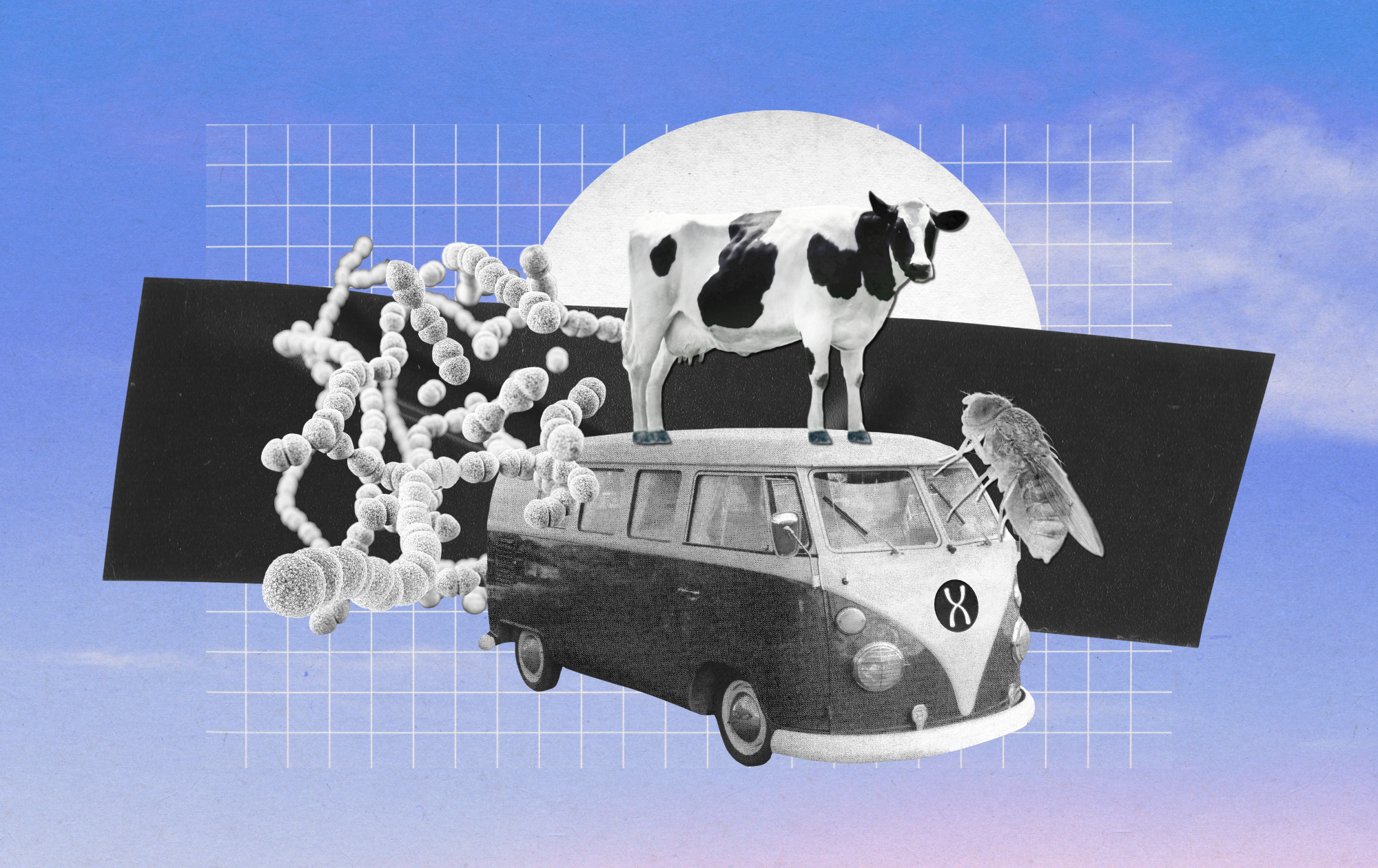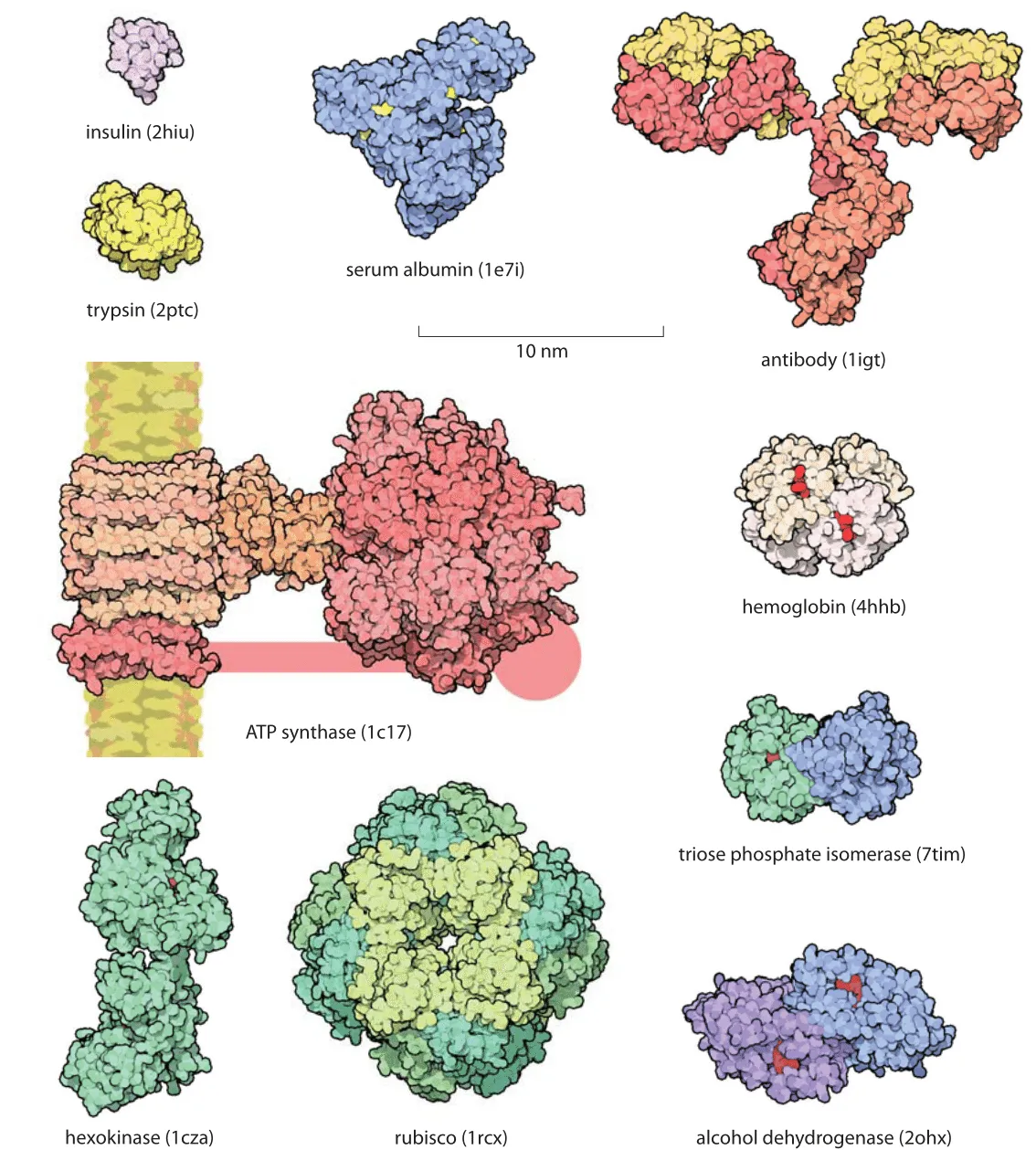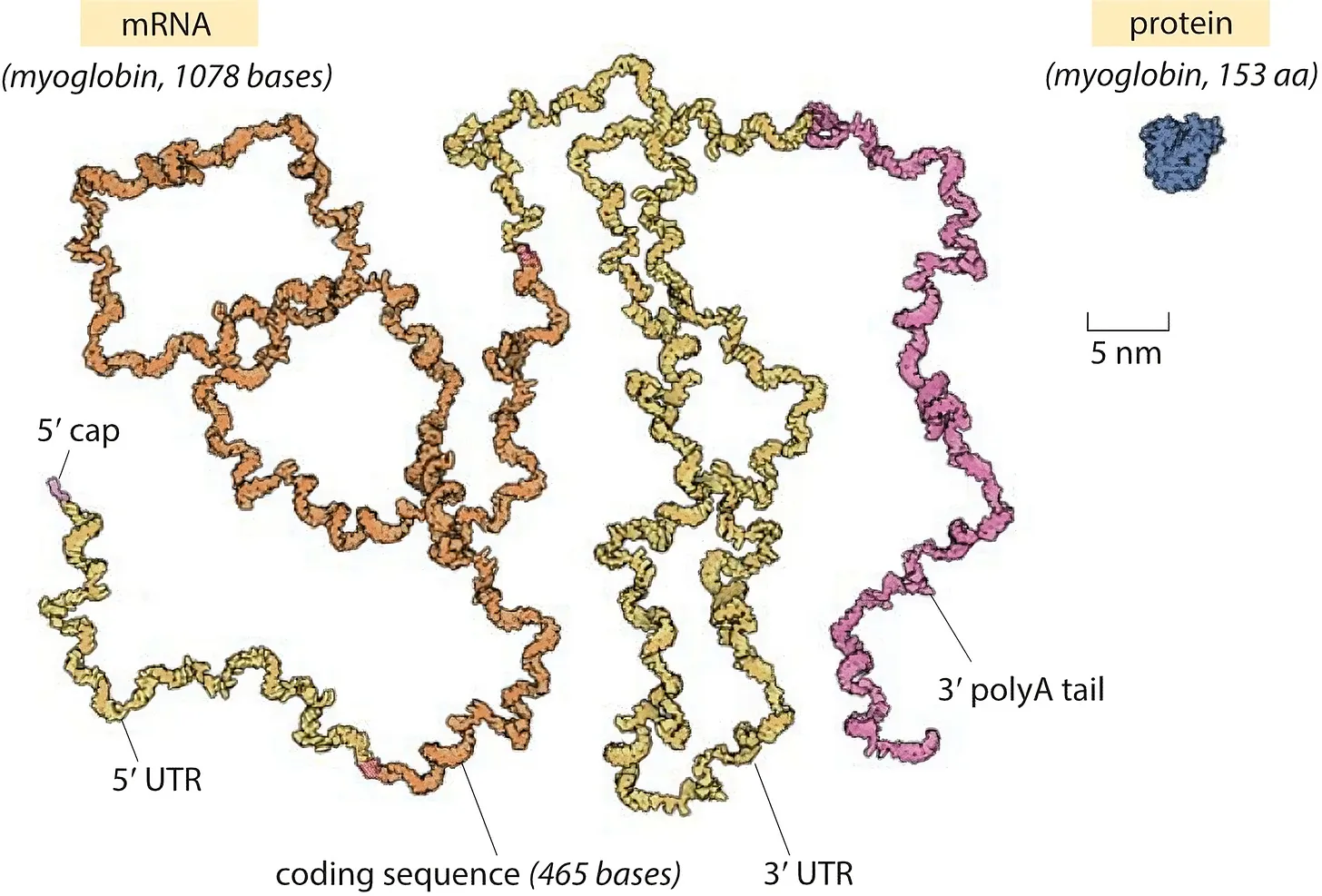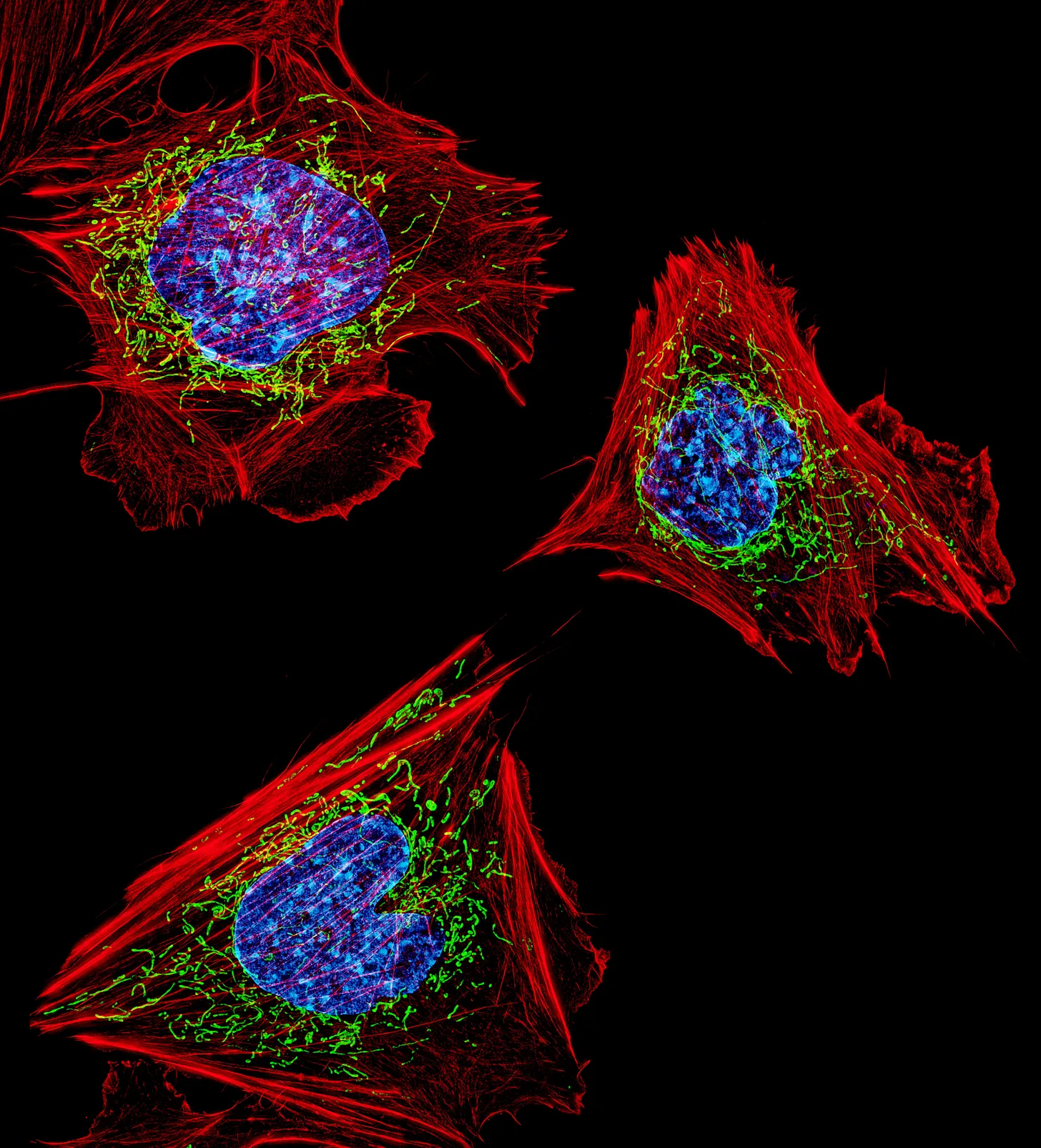Metaphors for Biology: Sizes

Biology can be hard to intuit, in part because it operates across vastly different scales, from single atoms all the way up to entire ecosystems. Students of biology therefore often first meet its agents and mechanisms through metaphors: molecules are charged balls connected by sticks! evolution designs organisms to maximize their fitness! mitochondria are the powerhouses of the cell! While metaphors give us qualitative handles to grasp, they often oversimplify complex ideas.
This is because most metaphors fail to address specifics — especially regarding numbers. Consider another common bio-metaphor: DNA is the blueprint of the cell. That’s useful for conceptual understanding, but how big is this blueprint? Is it as big as a novel or an encyclopedia? How much space does it take up? It’s possible to look up or calculate the answers to these questions; the human genome is 6.2 billion base pairs, which takes up about 10 cubic microns.1 But how big is that compared to the total volume of a cell? Is it most of it or just a tiny fraction?
To answer questions like these, you need more quantitative metaphors. Whereas a standard metaphor says that mitochondria are the powerhouses of the cell, a quantitative metaphor says how big a battery a mitochondrion would be, say, if a cell were a toaster. If qualitative metaphors are like containers, then quantitative metaphors are closer to yardsticks.
And these yardsticks are exceptionally useful down at the scales where biology operates. We all know cells are small. But so are proteins, nucleic acids, and water molecules. We often think of everything “small” as equally small, but that is not the case. Proteins are titanic, hulking machines compared to water molecules, and the mRNA that encodes a protein is orders of magnitude larger still!
To make the sizes and shapes of various biomolecules concrete, let’s imagine that each water molecule within a cell has been blown up to the size of a grain of sand.2 If this were the case, then …
{{signup}}
Proteins
- Proteins come in a variety of shapes and sizes, but a typical protein would now be a knobby ball the size of a blueberry.3
- The largest human protein, titin, would be a floppy spring 3-4 mm in diameter. Coiled loosely, it would be about as long as a golden retriever end-to-end but could stretch out to the height of a double-garage door.
- An antibody would consist of three blobby arms, each roughly the dimension of a grain of basmati rice, connected to a common center by a short chain.

DNA
- A nucleotide would be a paper-thin oblong disk about the width of a poppy seed (1mm, also the width of three grains of sand).
- To make double-stranded DNA, glue two stacks of nucleotides together side-to-side, then twist them so that they make a complete turn every ten bases. You should end up with a 2-stranded braid about as thick as a #2 pencil lead. Real nucleotides are extremely thin but have some space between them; for simplicity, imagine them as tightly-packed stacks of card stock. Short chains are stiff, but they start to get floppy around 5cm (2 inches).
- A typical human chromosome would be a thread of double-stranded DNA about 100,000,000 bases long, which is just long enough to span the English Channel (34 km).4 In its natural context, it’s usually a snarled hairball roughly the size of a bottlenose dolphin. During mitosis, it tightens up into a cow-length cylinder about one foot wide.5
- A typical bacterial chromosome is a thread or circle of double-stranded DNA a couple million bases long, which would have a length comparable to the height of the tallest buildings. It is normally loosely coiled into lots of twisty bundles, like a headphone cable left loose in a bag; in this form, it would be a meter or two across.6

Single-Celled Organisms
- Human viruses come in a variety of shapes and sizes, but most are balls of protein covered in a lipid membrane studded in protruding proteins, between ping-pong ball and soccer ball in size.
- E. coli (a fairly typical bacteria) is a capped cylinder one meter across and two meters long — about the size of a cow and weighing about two metric tons.
- Single-celled eukaryotes would come in a variety of shapes, and range between cow and large town in size, with most between whale-size and city-block-size. Yeasts would tend toward the smaller end, with Saccharomyces cerevisiae being a sphere the size of a medium-weight moving van. The largest amoebae, on the other hand, would be several kilometers across.
Human Cells and Organelles
- A “typical” human cell is a fibroblast, which is the cell that makes up most of skin and connective tissue. This cell likes to attach itself to a surface and spread itself into an irregular shape, which would be about the dimensions of an 5x5 square block of king-bed, standard-sized hotel rooms.
- The nucleus of such a fibroblast, which contains its DNA and transcriptional machinery, would be an oblong disk roughly the size of two hotel rooms. And remember those dolphin-sized human chromosomes? We need to pack 46 of these into the nucleus, or 92 if it’s about to divide (although the cell nucleus expands before cell division). The chromosomes take up only a few percent of the nucleus’s total volume, loosely packed most of the time and, therefore, tending to expand to fill the space.
- The mitochondria are coral-like webs of branching tubes reaching throughout the cell, with widths between that of a human and a cow.
- Various organelles are attached to a dense spiderweb of fibers called the cytoskeleton. These come in a variety of thicknesses, lengths, and consistencies, but most are either:
- actin fibers, which are tough threads that would be about as thick as a fat nail, or
- microtubules — stiff, hollow, finger-width tubes.
- The cell contains hundreds of lysosomes (organelles specialized for breaking down food, waste products, and damaged organelles), which would be blobby bags the size of a rat at the smaller end or house cat at the larger one.
- The cell is encased by a lipid membrane about the thickness of a thin porcelain tile (~5mm). It is rough with proteins, and probably7 looks patchy, with many temporary “rafts” of different densities of lipids and proteins. A 2x2cm square of membrane (about the dimensions of a key from a desktop keyboard) contains around 2,000 lipids and 10-15 proteins.

Organs and Body Parts
- A human hair is a towering cylinder of tightly-packed dead cells. Shape and thickness will vary by hair color and texture, but a fairly typical hair would be about as thick as a soccer pitch is long. At shoulder-length, the hair would extend about 250 kilometers, or long enough to cross California (or England) east to west.
- Human blood vessels vary massively in scale. The smallest capillaries would be as thin as five meters (smaller in cross-section than a fibroblast!), just large enough to pass one or two inflatable-pool-sized red blood cells at a time. In contrast, the aorta, where the heart pumps into, would almost extend across Washington D.C., with surfaces a couple of kilometers thick.
- A human eye would be an orb about 25 kilometers (15.5 miles) across, with a wall 0.5-1 kilometers thick. The cornea (the clear part at the front of the eye encompassing the pupil and iris) would be some 11 kilometers across. The retina (the “camera sensor” at the back of the eye) covers about three-quarters of the interior surface of the eye and would be made up of ten distinct layers of cells, each about 7-8 building stories tall.
- A human brain, removed from the body and placed on the ground, would span half the surface area of Belgium and almost reach space.
Animals
- Perhaps the smallest commonly-studied animal is C. elegans, a near-microscopic nematode worm consisting of exactly 959 cells.8 According to our metaphoric yardstick, this nematode would be a tube a kilometer long (about as long as the Golden Gate Bridge) and 40 meters (about 12 stories) high and wide.
- A fruit fly would be a behemoth some 2-3 kilometers from mouthparts to abdomen, and 1-2 kilometers across.9 Each eye would be a rough hemisphere made up of thousands of whale-sized facets, and every other vertex between facets would sport a giant guard-spike some twenty meters long (as long as a semi truck).
- The average human would be about 1,700 kilometers tall. The International Space Station would orbit somewhere around the knee.10 This human could cover the U.S. west coast with their stretched-out arms.
Manmade Things
Just to hammer home how compact biological entities are, let’s look at some human-made artifacts at the same scale:
- A US penny laying flat on the ground would now be a disk a kilometer and a half tall (a bit shy of twice the height of the Burj Khalifa) and nineteen kilometers across (a reasonable day’s walk for an experienced hiker).
- The ball from a fine-tipped ballpoint pen would form a sphere 400 meters tall — as tall as the Empire State Building. This 400-meter height is precise to within 250 millimeters (about 10 inches). It is not a perfect sphere, but it is surprisingly close — its manufacturing imperfections have an average height (or depth) of less than three centimeters (about an inch).
- A transistor would form a rectangular block about two centimeters (¾ inches) across.11 An iPhone processor has 15-20 billion of these blocks, and is roughly 10 kilometers on a side.
Room Scales and Larger
Unfortunately, the sand-as-water-molecule metaphor begins to lose its usefulness when we get to the scale of the spaces in which humans and other animals live. Arguably, it has already lost concreteness by the time you get to whole humans (do you really grasp the length of the U.S. west coast or the orbital height of the International Space Station?).
If you wanted to visualize, say, a hotel room at sand-as-water-molecule scale, you’d be talking about carpet fibers as tall as mountains and areas comparable to continents. And real organisms can operate over much larger distances than the width of a hotel room! Scaled up, the migrations of the monarch butterfly or the arctic tern would be literally astronomical, best measured in units of solar system radii. Traditionally, astronomical distance is where we start using quantitative metaphors to scale down.
This shift in metaphoric type is also useful — the difference between the scales of a cell and the scales of the everyday are like the difference between everyday earthly lengths and the smallest “astronomical” ones. In our next essay on metaphors, we’ll tackle the other dimension of biology: time.
{{divider}}
Samuel Clamons is a bioinformatics scientist at Illumina, Inc. with a PhD in Bioengineering and training in applied mathematics and computer science. Outside of his day job, he writes science fiction and researches theoretical questions in biology at Asimov Press.
Cite: Clamons, S. “Metaphors for Biology: Sizes.” Asimov Press (2025). https://doi.org/10.62211/27he-92qw
Header image by Ella Watkins-Dulaney.
Correction: This article was updated on 5 November 2025 to address discrepancies in the sizes of chromosomes and nuclei. The original estimates were based on entries reported in BioNumbers, which appear to be flawed. Also, a human cell packs 92 chromosomes into its nucleus prior to cell division, rather than 46.
Footnotes
- The human genome is diploid, hence the 6.2 billion figure.
- Sand comes in a surprisingly wide range of sizes, with average beach sand ranging from 0.1 mm to 0.5mm. For convenience, I’ve assumed sand with a diameter of 0.28 mm, which a) is well within “typical” range for beaches and b) conveniently makes sand exactly one million times larger than a water molecule.
- Large or small as the range of blueberry sizes is remarkably similar to the range of typical protein sizes.
- Approximately the width of Long Island, 20 miles, for American readers.
- Chromosomes aren’t just DNA, or even mostly DNA by volume — most of their bulk is made up of histones and other DNA-associated proteins. There’s also a bit of empty space, even in a condensed chromosome, but that only amounts to a few percent. See this article for more details. Unfortunately, although Bionumbers has an entry for chromosome volumes, it is a ludicrously large one. If we believe the number’s source, all the chromosomes put together add up to 920 µm3 when condensed, and 2,800 µm3during interphase. Compare to the ~2,000 µm3 volume of an entire fibroblast (which would have to contain all of those chromosomes).
- See this 2015 review by Badrinarayanan et al. for tons of detail on how bacteria arrange and compactify their genomes.
- These lipid rafts are widely but not universally believed to exist, and estimates of their size and lifetime vary widely.
- Not counting eggs and sperm, and males have a few more. We know these 959(ish) cells well enough that each one has a name.
- See this 2024 paper by Jürgens K.J. et al. for more details on fruit fly anatomy than you thought possible.
- If this seems low to you, that’s because the International Space station is a fairly low-flying satellite. In contrast, a GPS satellite orbits about 10x the height of the scaled-up human.
- Tech-savvy readers may note that this number doesn’t line up with modern “3nm architecture” and “5nm architecture” standards. That’s because the “nm” ratings on transistors stopped following the actual size of transistors sometime around 2008, and now refer to a kind of “performance equivalent.”
Always free. No ads. Richly storied.
Always free. No ads. Richly storied.
Always free. No ads. Richly storied.